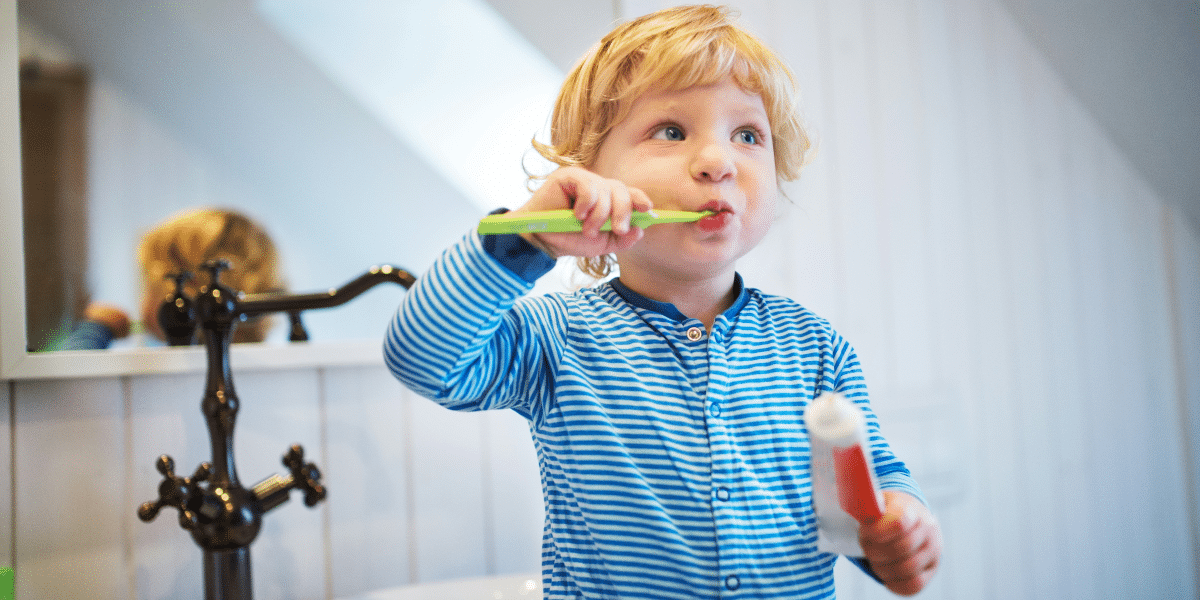What to Look for in Children’s Toothpaste Labels
One of the first things to check for on children’s toothpaste labels is the ADA (American Dental Association) Seal of Acceptance. This seal ensures that the toothpaste has met the ADA’s stringent guidelines for safety and effectiveness.
The ADA Seal of Acceptance guarantees that:
- The toothpaste contains the correct amount of fluoride.
- It has been rigorously tested for safety, especially for children.
- The toothpaste does not contain harmful ingredients, such as excessively abrasive materials, which could damage developing teeth.
Check for Fluoride and Age-Appropriate Labels
Fluoride is a crucial ingredient in children’s toothpaste, as it helps strengthen tooth enamel and prevent cavities. However, the amount of fluoride in toothpaste needs to be age-appropriate. Excessive fluoride for younger children can lead to a condition known as fluorosis, which can cause mild discoloration of developing teeth.
When reading the label, ensure the toothpaste indicates:
- Fluoride content: For children under the age of 6, choose toothpaste that contains the recommended amount of fluoride for their age group (usually around 1,000 to 1,500 ppm for older children). For toddlers and infants, you may opt for fluoride-free options until they can reliably spit out toothpaste.
- Age recommendation: Toothpastes often come with age guidelines to ensure they are safe and effective for specific developmental stages. Be sure to choose a toothpaste specifically labeled for your child’s age range. For example, toothpaste for infants will be milder and less abrasive, while toothpaste for older children will typically have higher fluoride content.
Understand Marketing Claims and Focus on Essentials
The toothpaste aisle is full of marketing claims designed to grab your attention. Words like “natural,” “whitening,” and “sugar-free” may sound appealing, but it’s important to know what features are truly essential for your child’s dental health.
Here’s how to navigate some of these common claims:
- “Natural” or “Organic”: Some parents prefer toothpaste with natural ingredients, free from artificial flavors, dyes, and sweeteners. While these options may be better for sensitive teeth and gums, be sure they still contain fluoride unless advised otherwise by your Pediatric dentist.
- “Whitening”: Whitening toothpaste may seem like a good idea for older kids, but it’s generally not recommended for younger children. The abrasive agents in these products could be too harsh for their enamel. Focus on cavity protection and enamel strengthening instead.
- “Sugar-Free” or “Xylitol”: Most children’s toothpaste today is sugar-free, using xylitol as a sweetener, which is a safer alternative for preventing tooth decay. While it’s a good feature, don’t rely solely on this claim. Always ensure the toothpaste also contains fluoride and is ADA-approved.
Understanding Toothpaste Ingredients
Common Ingredients in Children’s Toothpaste
Most children’s toothpastes contain a few key ingredients designed to clean teeth, protect enamel, and make the brushing experience enjoyable for kids. Here are some of the most common ingredients and their roles:
- Fluoride: This is the most important ingredient in toothpaste for preventing cavities. Fluoride strengthens tooth enamel, making it more resistant to acid attacks from bacteria and sugars in the mouth. It’s especially beneficial for growing teeth, helping to prevent early signs of decay.
- Abrasives: Mild abrasives such as silica or calcium carbonate are included to help remove food particles, plaque, and surface stains from teeth. These abrasives are gentle enough not to harm children’s softer enamel but effective enough to clean their teeth thoroughly.
- Flavoring Agents: To make brushing more appealing, children’s toothpaste often includes flavoring agents such as mint, strawberry, or bubblegum. These flavors are typically safe and designed to encourage regular brushing habits.
- Humectants: Ingredients like glycerin or sorbitol help maintain the toothpaste’s moisture and texture, preventing it from drying out. These humectants are safe for kids and help the toothpaste spread evenly on the teeth.
- Thickeners: Thickeners such as cellulose gum are added to create the desired consistency, giving toothpaste a smooth texture that’s easy for children to use.
Avoiding Harsh Additives: What to Watch Out For
While most children’s toothpastes are formulated to be safe, some additives can be too harsh for young teeth or cause discomfort. Pediatric dentists recommend parents pay attention to the following:
- Harsh Abrasives: Children’s enamel is softer than adults’, and using toothpaste with harsh abrasives can wear it down over time. Abrasives like calcium carbonate or hydrated silica are typically mild enough for children, but parents should avoid products designed for whitening, as they often contain stronger abrasives. Whitening toothpastes can be too abrasive for developing teeth and may cause sensitivity or damage the enamel.
- Artificial Sweeteners and Dyes: Many children’s toothpastes contain artificial sweeteners (such as saccharin) to enhance the flavor. However, some children may have sensitivities to these ingredients. Pediatric dentists often recommend choosing toothpaste without artificial sweeteners or dyes for kids with sensitive mouths or allergies. Natural toothpaste options often use xylitol, a plant-based sweetener that’s both safe and effective in preventing cavities.
- Sodium Lauryl Sulfate (SLS): This foaming agent is commonly used in toothpaste but may cause irritation in some children, especially those with sensitive gums or mouths. SLS can contribute to mouth sores or other issues. For children with sensitivity, pediatric dentists suggest opting for an SLS-free toothpaste.
Fluoride vs. Non-Fluoride Toothpaste: Which is better?
The Benefits of Fluoride Toothpaste
Fluoride toothpaste is widely regarded as the most effective way to prevent cavities. Here’s why it’s commonly recommended by pediatric dentists:
- Cavity Prevention: Fluoride strengthens tooth enamel, making it more resistant to acid attacks from bacteria and sugars in the mouth. This is especially important for children who are at higher risk of cavities due to poor brushing habits, sugary diets, or genetic factors.
- Remineralization: Fluoride helps repair early signs of tooth decay by remineralizing areas where acid has started to wear away the enamel. This can prevent small cavities from becoming bigger and requiring fillings.
- Widely Available and Endorsed: Most toothpaste brands offer fluoride options, and they carry the American Dental Association (ADA) Seal of Acceptance, which ensures their safety and effectiveness in preventing tooth decay.
However, fluoride toothpaste does have some drawbacks for very young children or those with specific health concerns.
The Downsides of Fluoride Toothpaste
- Fluorosis Risk: Fluorosis is a condition caused by consuming too much fluoride during the early years of tooth development. It can cause white spots or streaks on the teeth. Fluorosis typically occurs if young children swallow too much fluoride toothpaste before they are able to spit it out. For this reason, fluoride toothpaste is often not recommended for children under 2 years old unless directed by a dentist.
- Ingestion Concerns: For toddlers and younger children who may swallow toothpaste rather than spit it out, excessive fluoride ingestion can be harmful. Pediatric dentists may recommend using a very small amount (about the size of a grain of rice) to minimize the risk.
The Benefits of Non-Fluoride Toothpaste
Non-fluoride toothpaste is an alternative option for parents concerned about their child ingesting fluoride or if the child has specific health concerns. Here are the benefits:
- Safe for Younger Children: Non-fluoride toothpaste is generally recommended for children under 2 years old or for those who haven’t yet mastered spitting after brushing. This reduces the risk of swallowing fluoride and developing fluorosis.
- Natural and Gentle: Many non-fluoride toothpastes are marketed as natural options, often free from artificial sweeteners, colors, or foaming agents like sodium lauryl sulfate (SLS). This makes them a good option for children with sensitivities or allergies.
- Good for Low Cavity Risk: For children with a low risk of cavities—either due to a strong diet, good brushing habits, or regular dental checkups—non-fluoride toothpaste can still help keep their teeth clean without the added fluoride.
The Downsides of Non-Fluoride Toothpaste
- No Cavity Protection: The main drawback of non-fluoride toothpaste is that it doesn’t provide the same cavity-fighting benefits that fluoride does. If your child is at a higher risk for tooth decay, non-fluoride toothpaste may not be sufficient to protect their enamel.
- Limited Remineralization: Without fluoride, non-fluoride toothpaste cannot help remineralize early signs of tooth decay. This limits its effectiveness in preventing cavities or repairing minor enamel damage.
Published by: Khy Talara

















